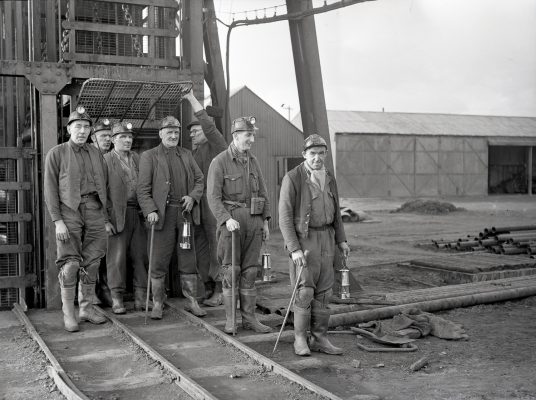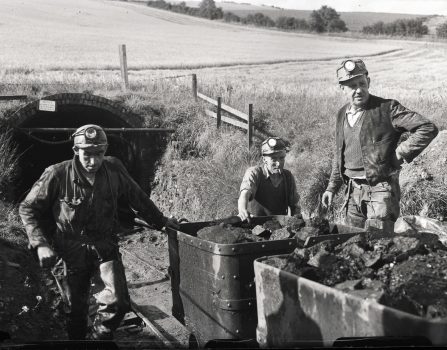Photographs of Miners, 1959-1960
Reference: BRO 1944/1/2273/2, BRO 1944/1/2952/10
Suggested age groups: KS2, KS3, KS4, KS5, Lifelong Learners
Subject areas: Environmental Portraiture, Photography, Mining
CONTEXT
Originally founded in 1951 as the Photo-News Service, the Photo Centre in Berwick was a staple of town life for over 65 years as a family-run press agency and photo studio.
Their premises at 17 Bridge Street had a well-equipped studio above the shop where commercial photography took place. The business also covered newsworthy events in the area and recorded family occasions and celebrations, marking milestones in the lives of several generations of townspeople.
The main coal mining areas in Northumberland were in the south east of the county around Ashington and Bedlington. In the late 19th century, many people from the north of the county migrated south to these areas. However, some coal was mined in North Northumberland, mainly at Scremerston, a couple of miles from Berwick. A village developed around the various pits worked there.
By 1944, the main pit at Scremerston had been closed but a subsequent one was opened nearby at Blackhill, beside Unthank. This employed over 200 men in the early 1950s but in early 1959 the National Coal Board decided to close it and offered the miners alternative work at Shilbottle, south of Alnwick or at Ashington. Initially miners travelled by bus to Shilbottle daily but eventually many families moved down there permanently.
Locally there was a campaign opposing the closure of the mine which led to some of the miners lobbying for the opening of a drift mine at Allerdean, close to the Blackhill Colliery. This opened in September 1960 and was run by a private company – Elsdon Coal Company. It didn’t employ many men and closed on 9 September 1966 as it was no longer considered viable.
The first image (BRO 1944/1/2273/2) shows the miners of the Blackhill Colliery, just outside Berwick, emerge from the pit for the final time. After a hard-fought campaign to save the mine, it closed on 20th February 1959. The closure resulted in many job losses.
The second photograph (BRO 1944/1/2952/10) shows the first coal from the Allerdean drift mine being brough to the surface in September 1960. After the closure of Blackhill Colliery in 1959, Allerdean mine was brought into use for the first time since 1908. Only a fraction of the Blackhill pitmen could be re-employed.
An environmental portrait is a photograph of someone in their usual environment, for example at home, in their workplace, or in an area that typically shows as aspect of the subject’s everyday life. The essence of environmental portraiture is to capture the subject in the context of their surroundings. The surroundings or background of the portrait is a key element as this is used to give further information about the person being photographed. The subject is often shown undertaking their usual tasks, such as doing an element of their job.
ARTISTS BANK
August Sander
Described as “the most important German portrait photographer of the early twentieth century”, August Sander spent his life documenting his fellow countrymen in straightforward, dignified portraits picturing farmers, merchants, civil servants, intellectuals, gypsies, and the insane so that they could be seen.
Example environmental portraiture images: Berlin Coal Carrier, 1929; Young Farmer, 1912-13; Farmer Working in the Fields, c.1930
Arnold Newman
Newman was credited with popularising environmental portraiture, a style that captures subjects in their surroundings and uses significant details to communicate their profession and personality. His environmental portraits mainly consisted of artists and politicians. He was also known for his carefully composed abstract still life images.
Example environmental portraiture images: Igor Stravinsky, 1946; Pablo Picasso, 1954; Andy Warhol, 1973
Alfred Eisenstaedt
German-born American photographer is best known for his candid black-and-white shots of celebrities, politicians, and captivating street shots.
Example environmental portraiture images: Gondolas, Venice, 1947; George Bernard Shaw at Typewriter, 1932; General Electric Turbine Plant, 1948
Jimmy Nelson
British photographer Jimmy Nelson focuses on taking environmental portraits of indigenous people from tribes that are about to disappear.
Environmental portraiture portfolio: https://www.jimmynelson.com/
ACTIVITIES
ACTIVITY 1
Background
The main coal mining areas in Northumberland were in the south east of the county around Ashington and Bedlington. In the late 19th century, many people from the north of the county migrated south to these areas. However, some coal was mined in North Northumberland, mainly at Scremerston, a couple of miles from Berwick. A village developed around the various pits worked there. By 1944, the main pit at Scremerston had been closed but a subsequent one was opened nearby at Blackhill, beside Unthank. This employed over 200 men in the early 1950s but in early 1959 the National Coal Board decided to close it and offered the miners alternative work at Shilbottle, south of Alnwick or at Ashington. Initially miners travelled by bus to Shilbottle daily but eventually many families moved down there permanently. Locally there was a campaign opposing the closure of the mine which led to some of the miners lobbying for the opening of a drift mine at Allerdean, close to the Blackhill Colliery. This opened in September 1960 and was run by a private company – Elsdon Coal Company. It didn’t employ many men and closed on 9 September 1966 as it was no longer considered viable.
SEE
See: Where was most coal mined in Northumberland?
See: Where was coal mined near Berwick?
See: When did Blackhill Colliery close?
See: When did Allerdean drift mine reopen?
THINK
Think: What were the main industries in Britain during the mid-20th century?
Think: How do these industries differ from what came before them?
Think: What are the main industries in Britain today?
Think: Why do you think Blackhill Colliery closed?
Think: Why did mines close down in the UK?
Think: What was the impact of mine closures personally, socially and economically for miners in Britain?
Think: How important was the mining industry in Britain?
Think: What impact does the mining industry have on the environment?
DO
Do: Research your local area. What was the dominant industry in your area during the mid-20th century?
Do: Research what the dominant industries are in your area today.
Do: In groups discuss what you think the dominant industry will be in your area 30 years from now.
Do: Imagine you are living 30 years in the future. Think about the industrial past of your area, along with its natural environment and transport connections. Make a proposal for a new industry in the area.
Do: Create a map showing the locations of mines in the UK during the 1950s.
Do: Create a timeline of maps for each decade between 1950 and now marking working mines in one colour and mines closed during that decade in a second colour, in the UK.
Do: Analyse your timeline of maps. What is the trend?
Do: In groups, debate the impact of closing mines in Britain. Can you come to a consensus on the main reasons for the decline of the mining industry?
Do: Create a poster showing the environmental impact of the mining industry.
Do: Come up with a plan for introducing environmentally friendly renewable energy sources in your local area.
Do: Write a newspaper article to accompany one of the photographs.
Do: Write a monologue from the perspective of a miner from Berwick who has lost their job. Think about how this will affect them and their family, will they have to move, what will they do?
Do: Create a case study exploring the relationship between coal and climate change.
Do: In groups, debate the relationship between coal and climate change. Should we be encouraging the extraction and use of fossil fuels?
Resources
https://flashbak.com/the-story-of-british-coal-in-photos-1930-1950-49158/
https://www.economicshelp.org/blog/6498/uncategorized/the-decline-of-the-uk-coal-industry/
https://www.mining-technology.com/features/timeline-a-decade-of-decline-for-uk-coal/
https://ourworldindata.org/death-uk-coal
https://www.wcml.org.uk/our-collections/working-lives/miners/
ACTIVITY 2
Background
An environmental portrait is a photograph of someone in their usual environment, for example at home, in their workplace, or in an area that typically shows as aspect of the subject’s everyday life. The essence of environmental portraiture is to capture the subject in the context of their surroundings. The surroundings or background of the portrait is a key element as this is used to give further information about the person being photographed. The subject is often shown undertaking their usual tasks, such as doing an element of their job.
SEE
See: What is an environmental portrait photograph?
See: What are the main characteristics of an environmental portrait?
See: What is shown in each of these photographs?
THINK
Think: What can you learn about the subjects in each of these photographs?
Think: What do you think the purpose of these photographs is?
Think: Are the photographs candid or posed?
Think: What equipment and techniques do you think were used to take these photographs?
Think: Do you think these photographs are good examples of environmental portraiture?
DO
Do: Choose an industry in your local area. Create a series of environmental portraits focusing on that industry.
Do: How would you photograph subjects differently depending on the industry or environment they are in? Design a series of shoots planning how you would capture subjects in different environments.
Do: Shadow someone for the day in the style of Sophie Calle, this could be a friend or family member for example. Produce a series of environmental portraits showing someone in the different day to day aspects of their life.
Do: Think about how different palettes of colours, shades and tones are associated with different industries, professions, and environments. Create a mood board showing ranges of colours, shades and tones in environmental portraits.
Do: Using your mood board, annotate and analyse which palettes are associated with which industries, environments, and professions.
Do: Experiment with taking photographs using different colour, shade, and tone palettes.
Do: Experiment with taking high key and low key images.
Do: Create your own environmental portraiture series working in your own style with your own theme, using palettes of colour, shade and tone to express the environment, industry or profession.
Resources
https://medium.com/@pixelmagazine/color-theory-for-photographers-an-introduction-ae23296fda6d
https://digital-photography-school.com/limited-color-palette-strong-images/
https://photographycourse.net/environmental-portraits/
https://fstoppers.com/education/closer-look-high-key-and-low-key-photography-547770
OTHER ONLINE RESOURCES
Early Photography
Science Museum website, page about history of photography: https://www.scienceandmediamuseum.org.uk/objects-and-stories/history-photography
British Library website, page about invention of photograph (Henry Fox Talbot): https://www.bl.uk/collection-items/invention-of-photography
Bodleian website, biography of Henry Fox Talbot: https://talbot.bodleian.ox.ac.uk/talbot/biography/
Photo Centre
Portrait of a Town exhibition: https://www.photocentreberwick.co.uk/portrait-of-a-town/work-and-industry
Photo Centre workshop resources: https://www.photocentreberwick.co.uk/learning
Environmental Portraiture
Headshot London blog, What is Portraiture? – https://www.headshotlondon.co.uk/blog/what-is-a-portrait-photography/
History of Photography, Portraits – https://notquiteinfocus.com/2014/10/16/a-brief-history-of-photography-part-11-early-portrait-photography/
Tate, Portraiture – https://www.tate.org.uk/art/art-terms/p/portrait
How portrait photography evolved over time – https://www.scancafe.com/blog/the-evolution-of-portrait-photography
Mining in Berwick
Coal mining in the Berwick area – http://www.berwickfriends.org.uk/history/north-northumberlands-industrial-heritage/coal-mining-in-the-berwick-area/
Blackhill Campaign film – https://player.bfi.org.uk/free/film/watch-blackhill-campaign-1963-online
Northumberland Gazette article on the 60th anniversary of the colliery’s closure – https://www.northumberlandgazette.co.uk/news/blackhill-coal-mine-remembered-60th-anniversary-its-closure-143464
History of the Berwickshire Naturalists and the coal mines of Northumberland – https://archive.org/details/historyofberwick4621berw/page/158/mode/2up



